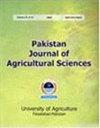国产土壤水分传感器在不同灌溉方式下小麦作物精确灌溉中的应用
IF 0.6
4区 农林科学
Q3 AGRICULTURE, MULTIDISCIPLINARY
引用次数: 0
摘要
利用传感器实时监测土壤水分有可能节约灌溉用水,提高水资源生产率。在费萨拉巴德农业大学农业研究生站水管理研究中心连续两年(2016-17年和2017-18年)进行了小麦生产的田间试验。田间灌溉方法包括洪水灌溉(帆布管)、穿孔管灌溉和不同种植几何形状和灌溉设计下的滴灌。基于传感器的灌溉系统是使用当地可用的材料开发的,以最大限度地降低设备开发成本和作物灌溉能耗。本试验采用的7种小麦作物处理分别是T1拉比钻机漫灌平播、T2 0.254m沟道漫灌床沟种植、T3 0.254m沟道穿孔管灌床沟播种、T4 0.203m沟道穿孔管灌溉床沟种植和T5 0.152m沟道穿孔管灌溉床槽种植,T6滴灌平台,横向间距0.914m,T7滴灌床,横向间距为0.914m。开发了一个基于信息技术的网络服务器,用于监测土壤水分状况,作为作物灌溉的决策支持系统。开发的传感器通过编码在云端发送土壤湿度信号,用于数据存储、重复使用和共享。灌溉是根据土壤水分状况进行的。基于微控制器的系统在小麦灌溉中进行了试验研究。配电箱(DB)中的Raspberry Pi-3(型号B)控制硬件出色地利用了国产土壤湿度传感器进行校准和灌溉水管理。I型(单探针)和II型(双探针)钢制传感器表现最好,因为在校准过程中R2值约为0.99,RMSE在3.30%-3.50%范围内。校准进一步提高了钢和铜传感器的精度。由于传感器在第一年(2016-17年)设计、开发和校准,并在第二年(2017-18年)正确安装,因此对作物和土壤参数产生了积极影响。滴灌处理(T6=359.56 mm和T7=358.65 mm)需要的平均水量明显低于所有其他处理,而漫灌处理(T1=431.55 mm和T2=424.95 mm)则需要的平均灌溉深度明显最大(α=0.05)。滴灌处理(T6和T7)的平均水分生产率值(14.30和14.20)高于漫灌处理(T1=9.6和T2=10.30)和穿孔管灌溉处理(T3=12.66,T4=12.43和T5=12.30)在洪水(T1=4139kg/ha,T2=4371kg/ha)和穿孔管灌溉处理(T3=4969kg/ha,T4=4872kg/ha,T5=4775.7kg/ha)下。穿孔管灌溉处理的小麦产量显著高于大水灌溉处理(α=0.5)。本文章由计算机程序翻译,如有差异,请以英文原文为准。
Application of indigenized soil moisture sensors for precise irrigation of wheat crop under various irrigation methods
Real time soil moisture monitoring using sensors has potential to save irrigation water and improve water productivity. Field experiments were carried out for two successive years (2016-17 and 2017-18) to produce wheat crop at the Water Management Research Center, Postgraduate Agricultural Research Station, University of Agriculture, Faisalabad. Field irrigation methods included flood irrigation (canvas pipe), perforated pipe irrigation, and drip irrigation under different planting geometries and irrigation designs. The sensor-based irrigation systems were developed using locally available material to minimize the cost of equipment development and energy consumption for crop irrigation. Seven wheat crop treatments used in this experiment were T1-flood irrigation flat sowing by rabi-drill, T2-flood irrigation bed furrow planting with 0.254 m furrow, T3-perforated pipe irrigation bed furrow planting with 0.254 m furrow, T4-perforated pipe irrigation bed furrow planting with 0.203 m furrow, T5- perforated pipe irrigation bed furrow planting with 0.152 m furrow, T6-drip irrigation flat with 0.914 m lateral spacing and T7- drip irrigation on beds with 0.914 m lateral spacing. An IT-based web server was developed for monitoring soil moisture status to serve as decision support system for applying irrigation to the crops. The developed sensors sent soil moisture signals on cloud for data storage, reuse and sharing purpose using coding. The irrigation was applied based on soil moisture status. The system based on micro-controller was tested for irrigating wheat crop. Raspberry Pi-3 (Model B) controlled hardware in distribution box (DB) made excellent use of indigenized soil moisture sensors for calibration and irrigation water management. Type-I (Single probe) and Type-II (Double probe) steel sensors performed best due to high R2 values of about 0.99 and RMSE in the range of 3.30% - 3.50% during calibration. The calibration further improved the accuracy of both steel and copper sensors. Since the sensors were designed, developed, and calibrated during the 1st year (2016-17) and properly installed in 2nd year (2017-18), therefore, have affected crop and soil parameters positively. Drip irrigation treatments (T6 = 359.56 mm and T7 = 358.65 mm) required significantly lowest mean amount of water than those by all the other treatments and the flood irrigation treatments (T1 = 431.55 mm and T2 = 424.95 mm) required significantly greatest (α = 0.05) amount of mean irrigation depth. Drip irrigation treatments (T6 and T7) produced high mean water productivity values (14.30 and 14.20) than those under flood irrigation treatments (T1 = 9.6 and T2 = 10.30) and perforated pipe irrigation treatments (T3 = 12.66, T4 = 12.43 and T5 = 12.30). The mean yield of wheat grain over two years was greater under drip irrigation treatments (T6 = 5145.1 kg/ha and T7 = 5091 kg/ha) than those under flood (T1 = 4139 kg/ha, T2 = 4371 kg/ha) and perforated pipe irrigation treatments (T3 = 4969 kg/ha, T4 = 4872 kg/ha, T5 = 4775.7 kg/ha). Perforated pipe irrigation treatments had significantly greater (α = 0.5) wheat grain yield than those under flood irrigation treatments.
求助全文
通过发布文献求助,成功后即可免费获取论文全文。
去求助
来源期刊

Pakistan Journal of Agricultural Sciences
AGRICULTURE, MULTIDISCIPLINARY-
CiteScore
1.80
自引率
25.00%
发文量
18
审稿时长
6-12 weeks
期刊介绍:
Pakistan Journal of Agricultural Sciences is published in English four times a year. The journal publishes original articles on all aspects of agriculture and allied fields.
 求助内容:
求助内容: 应助结果提醒方式:
应助结果提醒方式:


